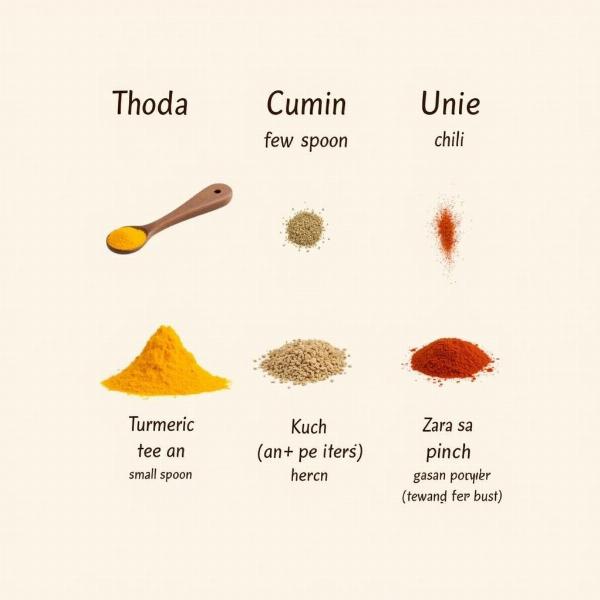Understanding the phrase “a little bit” and its various Hindi translations is crucial for anyone navigating the rich tapestry of the Hindi language. Whether you’re a language learner, a business professional, or simply interested in Indian culture, grasping the nuances of this seemingly simple phrase can greatly enhance your communication and understanding. “A little bit” conveys a sense of moderation, a slight degree, or a small quantity, and finding the right Hindi equivalent depends heavily on the context.
Finding the Right Hindi Equivalent for “A Little Bit”
“A little bit” doesn’t have a single, universally perfect translation in Hindi. The best choice depends on what you’re talking about—quantity, degree, or time. Are you referring to a small amount of food, a slight change in temperature, or a short period? This context is key. Let’s explore some common Hindi translations and their specific applications.
Expressing Small Quantities: थोड़ा (Thoda) and कुछ (Kuch)
When talking about a small quantity of something tangible, like food or water, thoda (थोड़ा) is often the most appropriate translation. For example, “I want a little bit of rice” would be “Mujhe thoda chawal chahiye” (मुझे थोड़ा चावल चाहिए). Similarly, kuch (कुछ) can be used to express “some” or “a little bit” but is generally used with countable nouns, like “a little bit of sugar” (kuch cheeni – कुछ चीनी).
Describing Degrees: थोड़ा सा (Thoda Sa) and ज़रा सा (Zara Sa)
For expressing a small degree or extent, thoda sa (थोड़ा सा) and zara sa (ज़रा सा) are excellent choices. These add a touch of politeness and subtlety. “The tea is a little bit hot” translates to “Chai thodi si garam hai” (चाय थोड़ी सी गरम है). Zara sa often implies an even smaller degree and can be used for requests like “Could you move a little bit?” (Zara sa hil sakte hain? – ज़रा सा हिल सकते हैं?).
Indicating Short Durations: थोड़ी देर (Thodi Der)
When referring to a short period, thodi der (थोड़ी देर) is the go-to phrase. “Wait a little bit” becomes “Thodi der ruko” (थोड़ी देर रुको). This phrase is specific to time and shouldn’t be used for quantities or degrees.
 Understanding Thoda, Kuch, and Zara
Understanding Thoda, Kuch, and Zara
Common Mistakes to Avoid
While these translations are helpful, it’s essential to avoid common pitfalls. Using thoda for time or thodi der for quantity can lead to confusion. Paying attention to the specific context and choosing the appropriate word is vital for accurate and effective communication.
Formal vs. Informal Usage
The choice of words can also indicate the level of formality. Zara sa often carries a more polite and formal tone than thoda sa. Being mindful of your audience and the situation can help you select the most appropriate expression.
Mastering the Nuances: Practice and Immersion
The key to mastering these subtle differences lies in practice and immersion. Listening to native speakers, reading Hindi texts, and actively using these phrases in conversation will enhance your understanding and fluency.
Beyond the Basics: Exploring Related Expressions
As you progress, exploring related expressions like “barely,” “slightly,” and “just a tad” will further enrich your vocabulary and allow for more nuanced communication. Learning synonyms and related phrases provides a deeper understanding of the language’s expressive capabilities.
Conclusion: Communicating Effectively with “A Little Bit” in Hindi
Understanding the various ways to express “a little bit” in Hindi is essential for clear and effective communication. By considering the context and choosing the appropriate translation, you can avoid misunderstandings and navigate the nuances of the Hindi language with confidence. Whether you’re ordering food, asking for a favor, or describing a subtle change, using the right words will enhance your interactions and deepen your appreciation for the richness of Hindi.
FAQ:
- What is the most common way to say “a little bit” in Hindi? Thoda (थोड़ा) is a common and versatile option.
- Can I use thoda for time? No, use thodi der (थोड़ी देर) for durations.
- What’s the difference between thoda sa and zara sa? Zara sa often implies a smaller degree and is more polite.
- How can I improve my understanding of these nuances? Practice, immersion, and listening to native speakers are key.
- Are there other ways to express “a little bit” in Hindi? Yes, there are related expressions like “kam” (कम) and “alpas” (अल्प).
Meaning-Hindi.in is your trusted partner for all your Hindi translation needs. We offer a comprehensive range of services, including business and commercial document translation, certified and legal document translation, technical and user manual translation, website and localization, educational and academic document translation, express translation, and specialized translation services. Contact us today for accurate, culturally sensitive, and high-quality Hindi translations. Email: [email protected], Phone: +91 11-4502-7584. Let Meaning-Hindi.in help you bridge the language gap and connect with the world.